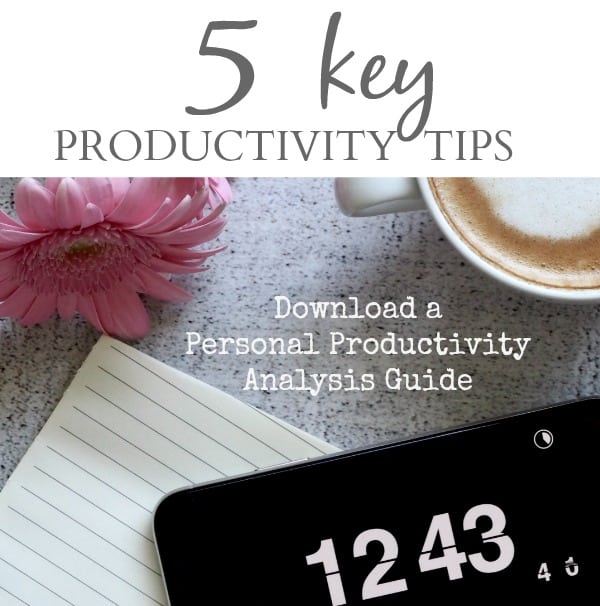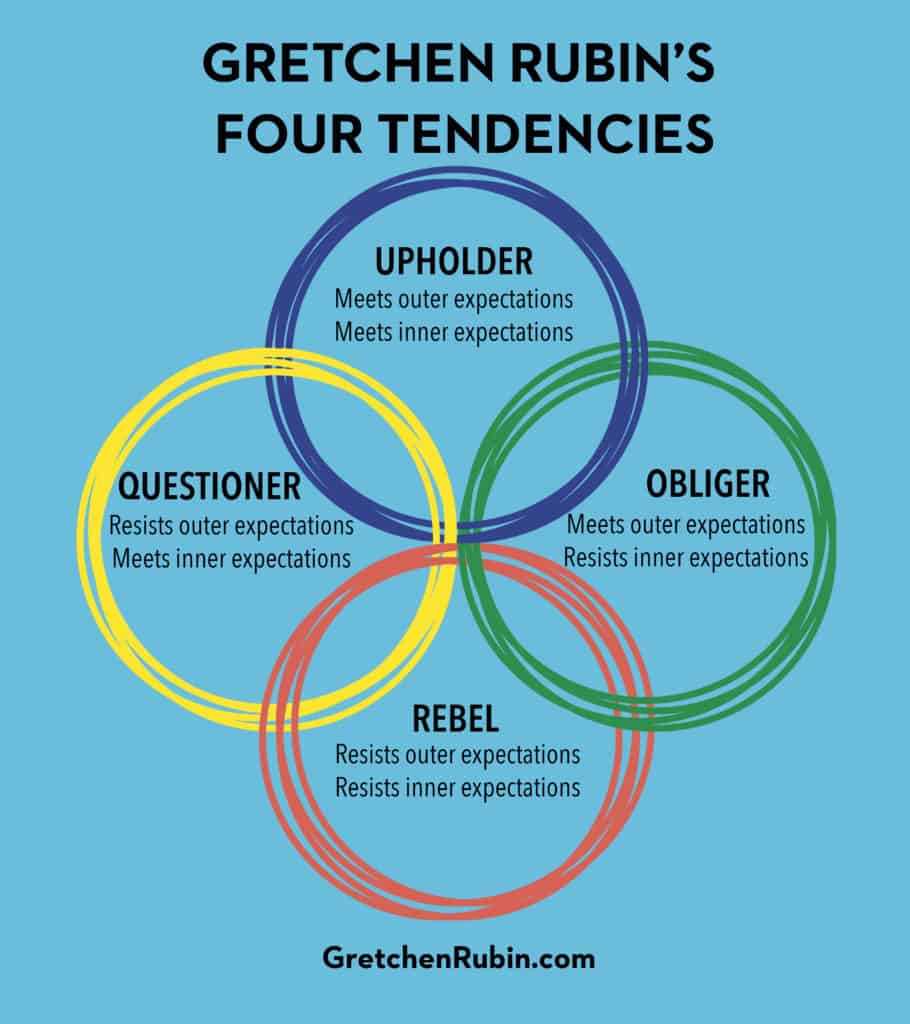Here are 5 key productivity tips, whether you’re making New Year’s Resolutions, or starting a new school year in September. In fact, to be the most productive you can be, you should revisit these tips several times a year and analyze how you’re doing. Grab a free Personal Productivity Analysis Guide below.

This post contains affiliate links for your convenience. I will receive a commission if you purchase from these links. Thank you.
Determine Your Time Wasters
This first tip is similar to the decluttering phase in organizing a physical space. Before you can organize the stuff you own, you have to get rid of nearly half of it! If all you do is rearrange an already-stuffed house, you will never truly be organized. It will always find its way back to a chaotic state. Similarly, if all you do is shuffle around your too-full daily flow, you still won’t be truly productive.
So, take a hard look at your typical day. Where are you wasting time? Even 5-10 minutes counts.
Now, don’t be so hard on yourself that you don’t allow the occasional Netflix binge during a stressful season. We’ve all been there. But if you’re watching a couple hours daily and still can’t find time to get your priorities and projects done, then you’ve just identified a daily time waster.
Have you ever gone on Facebook to message someone and then after 20 minutes of scrolling, you think to yourself, Why did I come on here? I can’t even remember what I’m supposed to be doing? Um, yeah, that’s me. Time waster. It’s better not to look at Facebook during the day when you need to be productive. Save your 10 minutes of scrolling as a reward in the evening for a job well done. That’s still over an hour a week!
If you’re not convinced to get rid of time wasters, then grab a copy of Deep Work by Cal Newport. It’ll change the way you work.
Personality Matters
Here’s a fact: We’re all unique individuals, and our productivity strengths and weaknesses will be directly related to our personalities. There are dozens of personality tests you could take, but I’ve found the most helpful to be Gretchen Rubin’s Four Tendencies quiz. Her framework analyzes how people respond to inner and outer expectations.
Some of us need an accountability group to keep us on task with our responsibilities. So, if you need this outer kind of expectation on you to be productive, then you would do better signing up for a fitness class where you know the pressure will be on you to attend because you have money on the line. However, if you don’t need that type of accountability to have follow-through, rather, you just need to be convinced in your own mind that you need to exercise, then you will probably fulfill that pledge to yourself and get out on a run by yourself each day.
What works for me might not work for you, and vice versa.
So figure out if you crave deadlines, outer accountability, peer groups, or if you resist them all. It really will make a difference in your productivity!
After reading The Four Tendencies and taking the quiz, I found out that I’m a Questioner. That means that once I’ve studied and analyzed something, if I have decided to take it on as an inner expectation, then I will usually follow through. But if an outside source asks me to accomplish something that seems meaningless, or like a waste of my time, I won’t respond to that outer expectation with the same passion or maybe even at all.
It’s been helpful seeing how my kids fall in this framework. Some kids crave schedules and deadlines, some kids dread them. Once again, personality makes all the difference with productivity, so it’s key to understand this area. If you’re homeschooling, check out this post to see how the four tendencies might play out in your homeschool. I also discussed this on the Homeschool with Moxie podcast episode #9.
You Have More Time Than You Think
Time is the most limited resource we have, because we can never make our days stretch longer than 24 hours. But it’s also a levelling factor. We’re all equal when it comes to the time we have.
Laura Vanderkam’s book, 168 Hours: You Have More Time Than You Think, is an eye-opening research project of multiple case studies and how people can be more productive with the time they have. 168 hours is the amount of time we all have in one week. Once you subtract working (40-50 hours) and sleeping (6-8 hours per night), we still have somewhere between 62 to 86 hours left to our discretion. That’s actually plenty of time to be productive!
Laura advocates time blocking, and I have learned to love this method too. Download a printable hourly calendar HERE.
One other tip for using the time you have is to plan your most important tasks – the ones that require your complete attention and energy – for the time of day that you work best. Throw away the advice that says everyone has to get up at 4AM to be productive. I have learned to embrace that I have never been, nor will ever be, a morning person. I just can’t do it. I can make myself get up early if I have to, but don’t ask me to be productive at that time of day.
So, give yourself permission to use the time that works best for you. It might be late into the night. In my current season of life, that how I juggle homeschooling, side gigs, and all my other responsibilities. You can read about a typical day in my life HERE.
Planned Neglect
The reality is that no one can do it all. No one is doing it all, regardless of what they project onto their social media accounts. Once you realize that, and stop falling into the comparison trap, you can find your peak of productivity by having a Don’t Do List. Start with your priorities, your WHY. If something doesn’t mesh with those, then you can say no without guilt. What will you actually plan to neglect this year?
From Overwhelm to Calm: Embracing Planned Neglect
Know Your Planning Style
You do you. Your best friend might do all her planning on project management apps, but going paperless might drive you crazy. Or, your sister might rock the detailed planner, while you would rather go with a simple wall calendar.
So, decide your best planning style and use it. Are you a post-it notes girl, or do you live for the paper planner?
Personally, I’m an eclectic planner – I love some online tools like Trello, but I can’t live without my paper lists.
One other tip to mention with planning styles is to not be afraid to make quarterly or monthly goals instead of only yearly goals. Sometimes we lose steam looking 12 months down the road for when we might reach our yearly goal. That’s where the 12 Week Year makes a lot of sense. Give yourself short sprints toward your big goals, and you’re more likely to reach them.
Recommended Resources
When I heard that Melanie Wilson from Psychowith6 was releasing a new book on productivity, I knew I had to get my hands on a copy! It’s a unique book, in that she doesn’t teach a new method or style. Rather, she explains the results of trying multiple productivity methods and reports back on the good, the bad, and the ugly of each. With suggestions for how she might try it again in the future (or not), it’s a handy resource for analyzing different techniques and deciding which ones to try for yourself.
The format of A Year of Living Productively is:
- summary of method
- instructions for how to implement (so that you don’t have to read dozens of books to try out a method!)
- results
- what worked
- what didn’t work
I love Melanie’s approach in this book, which is giving you permission to be flexible in changing what works for you now. What worked last year might not work today. And that’s fine. So, when your old approach is not keeping up with your current demands, this book is a great resource for finding new methods to try.
Grab a free downloadable Personal Productivity Analysis Guide at the bottom of this post or you can find it in my members-only resource library.
Finally, check out episode 3 of my podcast for more productivity tips!
Homeschool with Moxie Podcast #3 – Mom Hacks: Work Smarter & Not Harder



